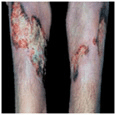Skin Signs of Renal Insufficiency 
Classification of Skin Changes
 Acute renal failure
Acute renal failure
 Edema
Edema
 Uremic frost (deposition of urea crystals on skin surface in severe uremia)
Uremic frost (deposition of urea crystals on skin surface in severe uremia)
 Chronic renal failure
Chronic renal failure
 Edema
Edema
 Uremic frost
Uremic frost
 Calciphylaxis
Calciphylaxis
 Bullous disease of hemodialysis (pseudoporphyria, see Section 23)
Bullous disease of hemodialysis (pseudoporphyria, see Section 23)
 Nephrogenic fibrosing dermopathy
Nephrogenic fibrosing dermopathy
 Acquired perforating dermatosis
Acquired perforating dermatosis
Calciphylaxis ICD-9: 275.49  ICD-10: E83.59
ICD-10: E83.59 
 Calciphylaxis is characterized by progressive cutaneous necrosis associated with small- and medium-sized vessel calcification and thrombosis.
Calciphylaxis is characterized by progressive cutaneous necrosis associated with small- and medium-sized vessel calcification and thrombosis.
 It occurs in the setting of end-stage renal disease, diabetes mellitus, and secondary hyperparathyroidism. Most often follows initiation of hemo- or peritoneal dialysis.
It occurs in the setting of end-stage renal disease, diabetes mellitus, and secondary hyperparathyroidism. Most often follows initiation of hemo- or peritoneal dialysis.
 Precipitating factors: glucocorticosteroids, albumin infusions, IM tobramycin, iron dextran complex, calcium heparinate, vitamin D.
Precipitating factors: glucocorticosteroids, albumin infusions, IM tobramycin, iron dextran complex, calcium heparinate, vitamin D.
 Preinfarctive lesions show mottling or livedo reticularis pattern, dusky red (Fig. 18-1A).
Preinfarctive lesions show mottling or livedo reticularis pattern, dusky red (Fig. 18-1A).
 Turn into black, leathery eschar (Fig. 18-1B) and ulcer with tightly adherent black or leathery slough. Ulcers enlarge over weeks to months; when debrided reach down to fascia and beyond; areas of plate-like induration can be palpated surrounding infarcted or ulcerated lesions (Fig. 18-2).
Turn into black, leathery eschar (Fig. 18-1B) and ulcer with tightly adherent black or leathery slough. Ulcers enlarge over weeks to months; when debrided reach down to fascia and beyond; areas of plate-like induration can be palpated surrounding infarcted or ulcerated lesions (Fig. 18-2).
 Extremely painful.
Extremely painful.
 Lower extremities, abdomen, buttocks, penis.
Lower extremities, abdomen, buttocks, penis.
 Azotemia. Calcium X phosphate ion product usually elevated. Parathormone levels usually but not always elevated. Dermatopathology: calcification of media of small- and medium-sized blood vessels in dermis and subcutaneous tissues.
Azotemia. Calcium X phosphate ion product usually elevated. Parathormone levels usually but not always elevated. Dermatopathology: calcification of media of small- and medium-sized blood vessels in dermis and subcutaneous tissues.
 Slowly progressive, despite therapy. Ulcus become secondarily infected.
Slowly progressive, despite therapy. Ulcus become secondarily infected.
 Management: treatment of renal failure, partial parathyroidectomy when indicated, debridement of necrotic tissue.
Management: treatment of renal failure, partial parathyroidectomy when indicated, debridement of necrotic tissue.
Related
Related posts:
Stay updated, free articles. Join our Telegram channel

Full access? Get Clinical Tree








